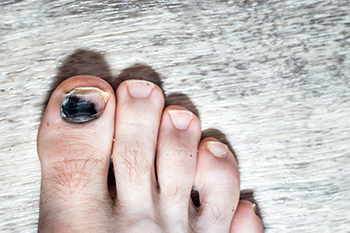
Tennis toe, also known as "subungual hematoma" or "runner's toe," is a common condition among athletes, particularly those involved in sports like tennis, soccer, football, squash, racquetball, basketball, running, and skiing. It's characterized by throbbing pain and a blue/black discoloration of the toenail caused by bleeding under the nail plate. The root cause of tennis toe lies in repetitive pressure and friction on the toenail when the toe is jammed against the front of the shoe's toe box. This often occurs during sudden stops, direction changes, and pivoting movements. The resulting damage causes blood to pool beneath the nail, leading to pain and discoloration, most commonly affecting the big toe. To prevent tennis toe, it is a good idea to keep toenails clipped short to minimize pressure and friction. Opt for well-fitting shoes, with some athletes recommending steel-toed tennis shoes for added protection. Consider playing on natural surfaces like grass or clay courts instead of synthetic ones. Tennis toe is a painful condition resulting from repeated toe trauma. If symptoms persist, it is suggested that you make an appointment with a chiropodist for any necessary treatment.
Toe pain is common and can have a variety of causes. Causes can range from a broken toe to an ingrown toenail. Many types of toe pain can be corrected, but any toe pain that inhibits your activities for an extended period should be discussed with a chiropodist. If you suffer from toe pain, please consult with one of the chiropodists from Complete Family Footcare & Therapy. Our clinicians can help you maintain the health of your feet.
Common Causes of Toe Pain
- Trauma or fracture
- Cuts, sores, or bruises
- Rheumatoid arthritis
- Gout
- Turf Toe
- Morton’s neuroma
- Blisters
- Corns
- Bunions
- Hammertoes
- Ingrown toenails
- Plantar warts
- Athlete’s Foot
Symptoms of Toe Pain
- Toe deformity
- Burning
- Numbness
- Toenail deformity
- Wart or ulcer
- Swelling
- Redness
When to See a Chiropodist
- Bleeding or severe swelling
- Trauma, such as a broken bone
- Discoloration or extreme swelling
- Inability to bear weight
- Persistent pain
- Wounds that won’t heal
Diagnosis of Toe Pain
A chiropodist can conduct a thorough examination of the painful toe or toes in order to determine the best course of treatment. The exam may include assessing the tenderness of the area, taking an X-ray or other diagnostic test, or assessing your gait and range of motion. A discussion of what led to the advanced pain issue may follow. Included will likely be a health history, as well as a list of medications you are taking and other previous injuries you may have sustained.
Treatment for Toe Pain
With such a wide range of possible causes for toe pain, treatment can be varied in scope and length. Sometimes, the chiropodist will recommend lifestyle and activity changes. In cases of trauma or other injuries, X-rays or imaging tests will likely be used to determine the severity of the problem, particularly if any bones have been broken. Treatment may also include injections of pain-relief medication or anti-inflammatory drugs. Certain injuries will require the splinting, bracing, or wrapping of injured toes. Orthotics or special shoes may be prescribed in cases of bone deformities and gait issues. Removal of warts, calluses, and corns may be needed. In other cases, such as with patients who have diabetes or rheumatoid arthritis, ongoing treatment may be required to avoid more serious problems.
